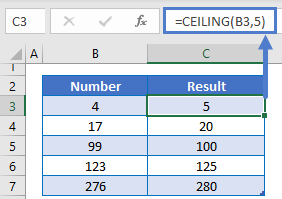CEILING Function – Round to Multiple in Excel, VBA, G Sheets
Download the example workbook
This tutorial demonstrates how to use the Excel CEILING Function in Excel to round a number up.

CEILING Function Overview
The CEILING Function Rounds a number up, to the nearest specified multiple.
To use the CEILING Excel Worksheet Function, select a cell and type:

(Notice how the formula inputs appear)
CEILING Function Syntax and Inputs:
=CEILING(number,significance)number – A number.
significance – The multiple to which to round the number. The sign much match the number. So if the number is negative, the significance must also be negative.
How to use the CEILING Function
Round up to Nearest 5, 50, or .5
To round up to the nearest 5, set the multiple argument to 5.
=CEILING(B3,5)
Alternatively you can round up to the nearest .5 or 50 by changing the multiple argument.
=CEILING(A2,0.5)
=CEILING(A2,5)
=CEILING(A2,50)

Round up to Nearest Quarter
You can also round a price up to the nearest quarter by setting multiple = .25.
=CEILING(A2,0.25)
Round Time
The CEILING Function makes it easy to round up time. To round time up to a certain increment, just enter your desired unit of time using quotations. Here we will round up to the nearest 15 minutes.
=CEILING(B3,"0:15")
Other ROUND Functions / Formulas
Excel / Google Sheets contains many other round functions. Here are quick examples of each:

Read our tutorials to learn more:
Below, we will point out a few functions in particular.
FLOOR and MROUND
The FLOOR and MROUND Functions work exactly the same as the CEILING Function, except the FLOOR Function always rounds down and the MROUND Function always rounds to the nearest multiple.
=MROUND(B3,5)
=FLOOR(B3,5)
=CEILING(B3,5)

ROUNDUP Function
Instead of using the CEILING Function to round up to a multiple, you can use the ROUNDUP Function to round a number up to a certain number of digits.
=ROUNDUP(B3,2)
CEILING in Google Sheets
The CEILING Function works exactly the same in Google Sheets as in Excel:

CEILING Examples in VBA
You can also use the CEILING function in VBA. Type:
application.worksheetfunction.ceiling(number,significance)Executing the following VBA statements
Range("C2") = Application.WorksheetFunction.Ceiling(Range("A2"), Range("B2"))
Range("C3") = Application.WorksheetFunction.Ceiling(Range("A3"), Range("B3"))
Range("C4") = Application.WorksheetFunction.Ceiling(Range("A4"), Range("B4"))
Range("C5") = Application.WorksheetFunction.Ceiling(Range("A5"), Range("B5"))
Range("C6") = Application.WorksheetFunction.Ceiling(Range("A6"), Range("B6"))
Range("C7") = Application.WorksheetFunction.Ceiling(Range("A7"), Range("B7"))
Range("C8") = Application.WorksheetFunction.Ceiling(Range("A8"), Range("B8"))
Range("C9") = Application.WorksheetFunction.Ceiling(Range("A9"), Range("B9"))will produce the following results

For the function arguments (number, etc.), you can either enter them directly into the function, or define variables to use instead.